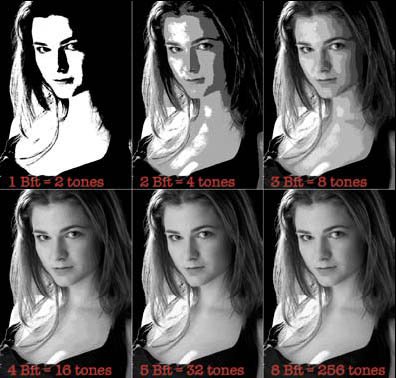articles/Lighting/lightingfordigital5-page3
Digital exposure for photography - part 3 of 1 2 3
by Dave Montizambert Published 01/12/2007

Two-bit pixels are strictly that, two bit, pretty well worthless for making images. Looking at the top row, centre image of Sarah in Image [5], I think you will agree that this image is better than the previous but still a long way from looking like continuous tone. A two-bit pixel can only be one of four possible tones; zero and zero for white, zero and one for light grey, one and zero for dark grey, and one and one for black. For any sort of real quality we need greater pixel depth, which means more bits per pixel. As you can see from the bit-depth image progression of Image [5], increasing the pixel depth by one-bit doubles the possible tonal or brightness levels - so from 2 to 3 bits goes from 4 to 8 levels, from 3 to 4 goes from 8 to 16 levels, and so on. Jumping up in bit depth to a more usable level, we find that an image made of 8 bit pixels breaks the greyscale down into 256 brightness levels; 256 levels easily fools the eye into believing that it is seeing continuous tone as in the image of Sarah on the bottom far right side of Image [5]. And so it seems that a greater pixel depth such as 8-bit and up is needed if we are to fool the eye into believing that a mosaic of square pixels is a continuous tone image.
In Image [5] we established that we need at least 8 bits to create a believable looking greyscale image, but what of colour? Creating colour digital images we need at least 8- bits for the red channel, 8-bits for the green channel, and 8-bits for the blue channel. 8+8+8 equals 24-bit colour as seen in top graphic of Image [6]. You will often hear the two interchangeably, 8-bit colour means 8 bits per channel, and 24-bit means the accumulation of 8 bits per channel in red/green/blue composite colour.
With 24-bit image files we end up with 16.8 million possible colours; each channel has 256 possible levels of tone - 256x256x256=16.8 million as seen in the bottom graphic of Image [6]. This is a lot of colour! In fact it is more than enough to create the illusion of the full visible spectrum.

Dave Montizambert lectures internationally on lighting, digital photography and Adobe Photoshop. He is also a published author having written two books on lighting and digital photography (www.montizambert.com) plus numerous magazine articles on these topics in North America, Europe, Russia and Asia.
Dave also creates Photoshop tutorial CDs & DVDs for www.software-cinema.com. Dave is available for lectures and workshops in your area and can be reached at montizambert@telus.net or www.montizambert.com. Dave Montizambert owns and operates Montizambert Photography Inc. located in downtown Vancouver. For the past 25 years his company has created photographic images to aid various organisations and companies with their communication needs. He has created images for clients such as: McDonalds Foods, Motorola, Atlanta Scientific/ Nexus Engineering, Toyo Tires, Tri-Star Pictures, Warner Brothers, Constantine Films of Germany, Chevron Canada, Cuervo Tequila, the Canadian Broadcasting Corporation, J&B Scotch, Hong Kong Bank, Chimera Softboxes, B.C. Lottery Corp., Blackcomb & Whistler Mountains, Tsing Tao Brewery of China, B.C. Hot House, Kona Bikes, No Fear Sports Gear, Kodak, and Canada Post. His work has won Georgie, Lotus, Hemlock, Studio Magazine, CAPIC, and Graphex awards
Please Note:
There is more than one page for this Article.
You are currently on page 3
- Digital exposure for photography page 1
- Lighting for Digital 5 page 2
- Digital exposure for photography page 3
1st Published 01/12/2007
last update 09/12/2022 14:55:49
More Lighting Articles
There are 16 days to get ready for The Society of Photographers Convention and Trade Show at The Novotel London West, Hammersmith ...
which starts on Wednesday 14th January 2026





